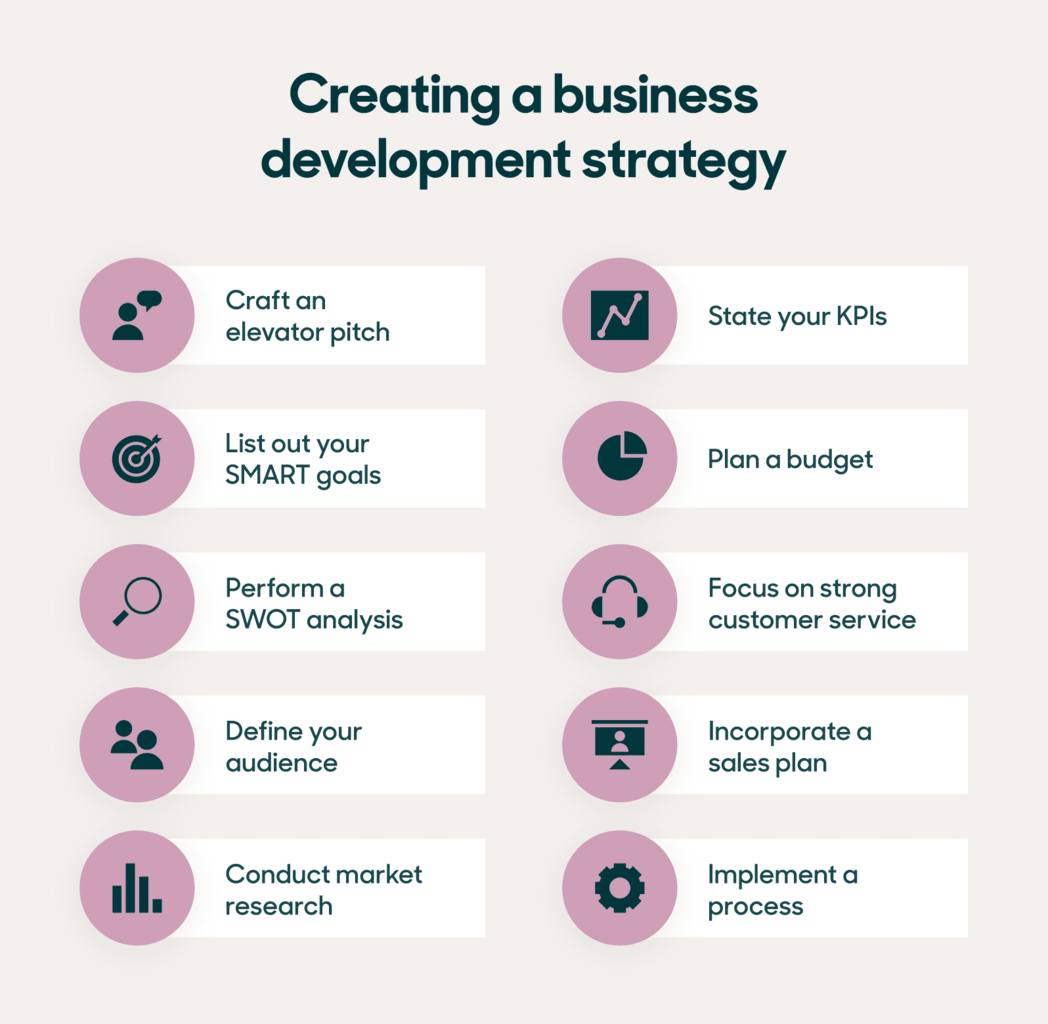Article • 8 min read
What is business development? Strategy, plan, and skills
Understand business development so you know what your BD department does and how to best use their skills.
Por Donny Kelwig, Contributing Writer
Última atualização em January 11, 2023
Anyone working in business development knows that it can be tough to explain. If someone asks you what you do for a living and you say, “Business development” or “biz dev,” you’ll probably get a quizzical look.
So if you don’t have a thorough grasp of what business development is, don’t worry—you’re not alone. The best way to understand biz dev is to break it into clear pieces.
Keep reading to explore business development in all its facets, including how to create a business development strategy.
Business development definition and variations
Business development (BD) is a strategy used to find new prospects and nurture them to help drive business growth.
According to Forbes, business development is “the creation of long-term value for an organization from customers, markets, and relationships.” That’s a simplified definition, and it still faces the hurdle of trying to encompass the massive range of responsibilities that go into BD. Every effort involved in business development is an activity that helps make a business better. But one could argue that that definition describes every action of every employee.
So, what makes business development different?
The easiest way to understand BD is to look at it as the umbrella that works to improve all other departments. Though BD isn’t sales, it helps improve sales; it’s not marketing, but it improves marketing.
Sales vs. business development

When it comes to sales development, there’s a more significant focus on researching and identifying leads and pushing them through the sales process to close a deal.
Business development involves finding new ways to grow and forming partnerships that can help open doors to fresh markets and opportunities.
What is new business development?
New business development means an existing company is developing a plan to introduce a new product or service under a new business model in a relatively unknown market. It’s aligned with business development because it seeks to expand and generate more revenue for the company. It has its own title because it can be a radical and risky approach.
Unlike normal business development, new business development takes the company outside its comfort zone and tries a tactic the company hasn’t previously attempted.
Example: A sit-down restaurant that exclusively serves dine-in guests employs new business development when it starts offering delivery or partners with a food delivery service like Grubhub.
Business development representatives and their roles
Employees who work for your biz dev department are called business development representatives, or BDRs.
BDRs work with nearly all your departments as they search for and implement new strategies, targets, prospects, and tactics for your company. Since BDRs work with many people and have varied skill sets, they need to come to the table with specific experiences and qualities.
Given the wide scope of responsibilities, it’s impossible to list all the activities that go into business development. That said, here are the key tasks your BD team will likely focus on:
Researching industry trends, company history, competitors, and prospects
Stakeholder mapping
Identifying growth opportunities
Brainstorming strategies
Experimenting
Lead generation and qualification
Prospecting
Cross-departmental project management
Partnership management
Data analysis
State of Sales 2022
Learn about the most pressing issues facing sales organizations today, what the dawn of conversational CRM means for your tech stack, and how you can come out stronger.
Business development strategy overview: How to create one in 10 steps

BD activities revolve around implementing a business development strategy. But how do you create that strategy?
All BD strategies begin with a plan and goals—start developing your own business development strategy by following the steps below:
1. Craft an elevator pitch
You need a concise 30-second pitch for any plan, including a BD plan. Want to go the extra mile? Craft several sales pitches and see which ones are most effective. You’ll be able to pitch while simultaneously conducting market research.
An elevator pitch summarizes what your business does, who you serve, and how your business differs from competitors. The goal of your elevator pitch is to open up the conversation about how you can serve your customers. When crafting your pitch, here are some best practices to follow:
Be brief
Use clear language
Be specific
Include a call to action
2. List your SMART goals
The SMART system is a great tool for business development goals. SMART goals are those that are Specific, Measurable, Attainable, Relevant, and Timely. For example, a good SMART goal for a business development strategy could be:
“I will aim to improve first-response time for customer issues by increasing the number of customer service staff from 10 to 15 people in the next three quarters.”
By following the SMART system, you’ll keep your goals aligned with those of other departments and ensure they’re achievable with your current resources.
3. Perform a SWOT analysis
SWOT analysis stands for Strengths, Weaknesses, Opportunities, and Threats. It’s an effective tool for business development because it helps you pinpoint your growth areas. The best way to use SWOT is to pick a specific aspect of your business to analyze. When conducting a SWOT analysis, keep these questions in mind:
What needs do our services/products solve for a customer?
What is our value proposition?
Are there any obstacles in the way of achieving goals?
You can also pair this with a positioning statement to help guide your analysis.
Example: If you’re looking to launch a new product, you can look at what your company does well, what it does poorly, where it might be missing opportunities, and what other companies might be doing better.
4. Define your audience
Next, define your target audience—this can help you determine who you want to attract as potential new clients. While you want to get specific about who to target, avoid getting so specific that you run out of prospects. You can do this by:
Analyzing competitors
Creating personas
Identifying industry trends
5. Conduct market research
Perform research to determine who your competitors are and what your customers want and need. You should know your customers’ problems and how you can solve them.
You can gain valuable insights into your audience’s needs through customer surveys. Eighty percent of companies that see year-over-year growth use surveys to collect customer experience data. Here are tips for creating a survey:
Determine the goal of your survey
Make sure your questions are unbiased
Send surveys through relevant channels
Keep them short and to the point
6. State your KPIs
To evaluate your plan’s success, you need to identify measurable data points through which you can document positive (or negative) outcomes. You can do this through key performance indicators (KPIs).
Depending on what you’re assessing, these KPIs can range from revenue changes to leads and conversion rates. The important thing is that you choose specific KPIs to complement your plan. Some biz dev KPIs include:
Opportunities created
Proposals sent
Sales activities performed
Client acquisition rate
Deals closed
7. Plan a budget
Possibly the most important aspect of your plan is your budget. Your company must be able to afford your plan before approving it and starting implementation.
Keep your proposed budget realistic, but don’t be afraid to push. After all, if your plan works, you should be able to make that money back. Be sure to include these elements in your business budget:
Balance sheet
Cash flow statement
Income statement
8. Focus on strong customer service
High-quality customer service should be top of mind—it could be the difference between a customer choosing you over a competitor.
Maintain good customer support with existing customers, too, to ensure you build a lasting relationship with them. Plus, if they continually have positive experiences with your team, they may refer other contacts to your business.
9. Incorporate a sales plan
A business development strategy isn’t whole without a sales plan. A sales plan helps outline your sales strategy and includes:
Your company goals and objectives
A strategy on how to achieve those goals
Team roles and responsibilities
Performance monitoring and benchmarks
Although this is centered around the sales team, it can provide your biz dev team with helpful insights.
10. Implement a process
Once you have a solid plan, implementation ideally becomes a mere matter of assigning and supervising. The steps for implementation are going to vary based on your plan’s parameters, but here are a few things to keep in mind when you launch:
- Hold regular meetings: Lead cross-departmental status meetings to keep everyone on the same page.
- Streamline communication: Centralize communication and simplify data access with appropriate software, including lead generation software and sales force automation (SFA).
- Don’t rush it: Remember that it’s a marathon, not a sprint. Business development is about long-term growth, so look at trends rather than sweating over the roller-coaster of monthly numbers.
- Ensure your BD plan aligns with individual department plans: Sales managers are also responsible for setting goals for their team, and those goals are just as important as yours. Clear communication and SFA software can ensure your goals aren’t working against each other.
Use a CRM to align your business development plans

Business development is all about facilitating communication between departments to achieve new business goals. The best way to align your company with a unified vision is through a CRM.
With a simple CRM like Zendesk Sell, communication between your business development team and all other departments becomes effortless. Plans can move and adjust in real time in response to everything from marketing clicks to sales tracking. (If you’re new to the CRM world, we’re happy to walk you through it with our CRM software explainer.)
Your BD team already has a thousand things to juggle every day, so why make their lives harder? Request a demo of Zendesk Sell today to keep your biz dev team—and your business—ahead of the competition.
